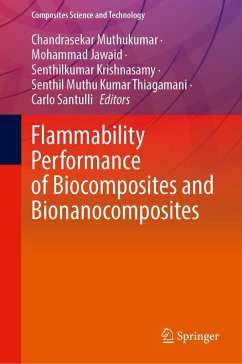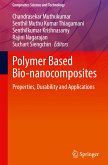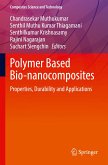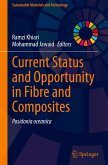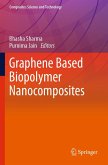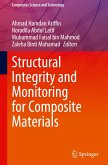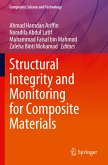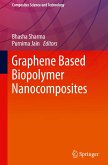Flammability Performance of Biocomposites and Bionanocomposites
Herausgegeben:Muthukumar, Chandrasekar; Jawaid, Mohammad; Krishnasamy, Senthil Kumar; Thiagamani, Senthil Muthu Kumar; Santulli, Carlo
Flammability Performance of Biocomposites and Bionanocomposites
Herausgegeben:Muthukumar, Chandrasekar; Jawaid, Mohammad; Krishnasamy, Senthil Kumar; Thiagamani, Senthil Muthu Kumar; Santulli, Carlo
- Gebundenes Buch
- Merkliste
- Auf die Merkliste
- Bewerten Bewerten
- Teilen
- Produkt teilen
- Produkterinnerung
- Produkterinnerung
This book explores the flammability characteristics and fire-retardant mechanism of the natural fiber-based composites and biocomposites reinforced with the various fire retardant fillers based on the thermoset, thermoplastic and elastomers. Biocomposites are increasingly viewed as viable alternatives to synthetic fiber-reinforced composites for low- to medium-strength application. However, certain applications may involve the use of such material in elevated temperatures and conditions where the material can be subjected to fire during its service life. Thus, it is essential to understand the…mehr
Andere Kunden interessierten sich auch für
![Polymer Based Bio-nanocomposites Polymer Based Bio-nanocomposites]() Polymer Based Bio-nanocomposites136,99 €
Polymer Based Bio-nanocomposites136,99 €![Polymer Based Bio-nanocomposites Polymer Based Bio-nanocomposites]() Polymer Based Bio-nanocomposites136,99 €
Polymer Based Bio-nanocomposites136,99 €![Current Status and Opportunity in Fibre and Composites Current Status and Opportunity in Fibre and Composites]() Current Status and Opportunity in Fibre and Composites100,99 €
Current Status and Opportunity in Fibre and Composites100,99 €![Graphene Based Biopolymer Nanocomposites Graphene Based Biopolymer Nanocomposites]() Graphene Based Biopolymer Nanocomposites121,99 €
Graphene Based Biopolymer Nanocomposites121,99 €![Structural Integrity and Monitoring for Composite Materials Structural Integrity and Monitoring for Composite Materials]() Structural Integrity and Monitoring for Composite Materials113,99 €
Structural Integrity and Monitoring for Composite Materials113,99 €![Structural Integrity and Monitoring for Composite Materials Structural Integrity and Monitoring for Composite Materials]() Structural Integrity and Monitoring for Composite Materials113,99 €
Structural Integrity and Monitoring for Composite Materials113,99 €![Graphene Based Biopolymer Nanocomposites Graphene Based Biopolymer Nanocomposites]() Graphene Based Biopolymer Nanocomposites121,99 €
Graphene Based Biopolymer Nanocomposites121,99 €-
-
-
This book explores the flammability characteristics and fire-retardant mechanism of the natural fiber-based composites and biocomposites reinforced with the various fire retardant fillers based on the thermoset, thermoplastic and elastomers. Biocomposites are increasingly viewed as viable alternatives to synthetic fiber-reinforced composites for low- to medium-strength application. However, certain applications may involve the use of such material in elevated temperatures and conditions where the material can be subjected to fire during its service life. Thus, it is essential to understand the thermal decomposition characteristics and fire response of the biocomposites with respect to the type of fiber reinforcements and type of matrix. The book also explores post-fire mechanical properties of the composites. This book is intended for researchers and industrial practitioners who specialize in developing new materials for fire-resistant and low thermal degradation properties.
Produktdetails
- Produktdetails
- Composites Science and Technology
- Verlag: Springer / Springer Nature Singapore / Springer, Berlin
- Artikelnr. des Verlages: 89208585, 978-981-95-2388-7
- Seitenzahl: 352
- Erscheinungstermin: 16. November 2025
- Englisch
- Abmessung: 241mm x 160mm x 25mm
- Gewicht: 692g
- ISBN-13: 9789819523887
- ISBN-10: 9819523885
- Artikelnr.: 75175059
- Herstellerkennzeichnung
- Springer-Verlag GmbH
- Tiergartenstr. 17
- 69121 Heidelberg
- ProductSafety@springernature.com
- Composites Science and Technology
- Verlag: Springer / Springer Nature Singapore / Springer, Berlin
- Artikelnr. des Verlages: 89208585, 978-981-95-2388-7
- Seitenzahl: 352
- Erscheinungstermin: 16. November 2025
- Englisch
- Abmessung: 241mm x 160mm x 25mm
- Gewicht: 692g
- ISBN-13: 9789819523887
- ISBN-10: 9819523885
- Artikelnr.: 75175059
- Herstellerkennzeichnung
- Springer-Verlag GmbH
- Tiergartenstr. 17
- 69121 Heidelberg
- ProductSafety@springernature.com
Dr. Chandrasekar Muthukumar is presently working as an Associate Professor in the Department of Aerospace Engineering, Hindustan Institute of Technology and Science, Chennai, India. He graduated with a Bachelor's degree in Aeronautical Engineering from Kumaraguru College of Technology, Coimbatore, India. His Master’s degree in Aerospace Engineering was from Nanyang Technological University-TUM ASIA, Singapore. He received his Ph.D. in Aerospace Engineering from Universiti Putra Malaysia (UPM), Malaysia. His Ph.D. was funded through a research grant from the Ministry of Education, Malaysia. During his association with the UPM, he obtained an internal research fund from the University worth 16,000 MYR and 20,000 MYR, respectively. His research interests include Fiber Metal Laminate (FML), natural fibers, biocomposites, aging, and their characterization. He has published 150+ research articles in reputed SCI journals, authored, and co-authored book chapters and conference proceeding articles. He was featured in the Top 2% Scientist list released by Stanford University, USA for the year 2023. Dr. Mohammad Jawaid is currently working as a Senior Fellow (Professor) at Biocomposite Technology Laboratory, Institute of Tropical Forestry and Forest Products (INTROP), Universiti Putra Malaysia (UPM), Serdang, Selangor, Malaysia, and also has been a visiting professor at the Department of Chemical Engineering, College of Engineering, King Saud University, Riyadh, Saudi Arabia, since June 2013. He has more than 20 years of experience in teaching, research, and industries. His area of research interests includes hybrid composites, lignocellulosic reinforced/filled polymer composites, advance materials: graphene/nanoclay/fire retardant, modification and treatment of lignocellulosic fibers and solid wood, biopolymers and biopolymers for packaging applications, nanocomposites and nanocellulose fibers, and polymer blends. So far, he has published 55 books, 75 book chapters, more than 400 peer-reviewed international journal papers, and several published review papers under top highly cited articles in ScienceDirect. Senthil Kumar Krishnasamy, Ph.D., is an Associate Professor in the Department of Mechanical Engineering at Francis Xavier Engineering College, Tirunelveli, Tamil Nadu, India. He earned a bachelor’s degree in mechanical engineering at Anna University, Chennai, India, in 2005. He earned a master’s degree in CAD/CAM at Anna University, Tirunelveli, in 2009. He earned a Ph.D. in mechanical engineering at Kalasalingam University in 2016. From 2010 to 2018, Dr. Krishnasamy worked in the Department of Mechanical Engineering at Kalasalingam Academy of Research and Education (KARE), India. He completed a postdoctoral fellowship at Universiti Putra Malaysia, Serdang, Selangor, Malaysia, and King Mongkut’s University of Technology North Bangkok (KMUTNB) under the research topics of experimental investigations on mechanical, morphological, thermal, and structural properties of kenaf fiber/mat epoxy composites and sisal composites and fabrication of eco-friendly hybrid green composites on tribological properties in a medium-scale application. Senthil Muthu Kumar Thiagamani, Ph.D., is an Associate Professor in the Department of Mechanical Engineering at Kalasalingam Academy of Research and Education (KARE), Tamil Nadu, India. In 2004, he earned a Diploma in Mechanical Engineering at the State Board of Technical Education and Training, Tamil Nadu. In 2007, he graduated from Anna University, Chennai, with a Bachelor’s degree in Mechanical Engineering. In 2009, he obtained his Master’s degree in Automotive Engineering at Vellore Institute of Technology, Vellore. In 2018, he earned a Ph.D. in Mechanical Engineering, specializing in Biocomposites, at KARE. He completed postdoctoral research in the Materials and Production Engineering Department at the Sirindhorn International Thai-German Graduate School of Engineering (TGGS), KMUTNB, Thailand, in the year 2019. He started his academic career in 2010 as Lecturer in Mechanical Engineering at KARE. Carlo Santulli is an Associate Professor at the School of Science and Technology in Università di Camerino, Italy. Here, he lectures on materials science, natural fibers and biocomposites, waste management, and environmental sustainability. He owns a M.Sc. in chemical engineering (Università La Sapienza, 1991), an M.A. in arts (modern history) (Università La Sapienza, 2001), an M.Sc. in Environmental Decision Making (EDM) (Open University, 2004), and a Ph.D. in materials science and engineering (University of Liverpool, 2000). His research interests over 35+ have been composites, natural fibers, biopolymers, agro- and food waste management, and biomimetics. He is a referee for over 80 journals in various fields concerning materials science and sustainability. He has been an invited Professor in various universities in India, Malaysia, and across Europe.
Introduction to flammability tests and fire retardant mechanisms of the Biocomposites and Bionanocomposites.- Part-I Thermoset polymers.- Flammability characteristics of the Phenolic resin based biocomposites and bionanocomposites.- Fire retardant properties of the Epoxy resin based Biocomposites and bionanocomposites.- Flammability properties of the Polyester resin based Biocomposites and bionanocomposites.- Flammability characteristics of the Vinyl ester resin based Biocomposites and bionanocomposites.- Flame retardancy properties of the Biocomposites and bionanocomposites with recycled thermoset polymers.- Part - II Thermoplastic polymers.- Flame retardancy characteristics of the Polypropylene (PP) based biocomposites and bionanocomposites.- Fire retardant properties of the Polylactic acid (PLA) based biocomposites and bionanocomposites.- Flammability characteristics of the Polyethylene terepthalate (PET) based biocomposites and bionanocomposites.- Thermal decomposition and flame retardancy properties of the PHBV and PVC based biocomposites and bionanocomposites.- Flammability performance of the HDPE and LDPE based biocomposites and bionanocomposites.- Flame retardancy properties of the Biocomposites and bionanocomposites with recycled thermoplastic polymers.- Part - III Elastomers.- Fire retardant properties of the Styrene butadiene rubber based biocomposites and bionanocomposites.- Flammability characteristics of the Silicone rubber based biocomposites and bionanocomposites.- Thermal decomposition and flammability performance of the Nitrile rubber based biocomposites and bionanocomposites.- Part - IV Synergistic effect of fire retardant fillers and polymer blends.- Synergistic flame retardant effects of Bionanocomposites reinforced with various combinations of the fire retardant fillers.- Synergistic effects of flammability performance of the hybrid composites reinforced with the various natural fibres.- Synergistic effects of fire retardant fillers and polymerblends on flammability characteristics of the Bicomposites and Bionanocomposites.- Part - V Fire modelling.- Predictive modelling of fire induced damages in the Biocomposites.- Fire modelling of thermal response of the Biocomposites.- Modelling of the post-fire tension, compression and bending properties of the Biocomposites.- PART - VI Applications.- Fire retardant polymeric Biocomposites and bionanocomposites for the textile applications.- Fire retardant polymeric Biocomposites and bionanocomposites for the automotive and marine applications.- Fire retardant polymeric Biocomposites and bionanocomposites for the aerospace applications.
Introduction to flammability tests and fire retardant mechanisms of the Biocomposites and Bionanocomposites.- Part-I Thermoset polymers.- Flammability characteristics of the Phenolic resin based biocomposites and bionanocomposites.- Fire retardant properties of the Epoxy resin based Biocomposites and bionanocomposites.- Flammability properties of the Polyester resin based Biocomposites and bionanocomposites.- Flammability characteristics of the Vinyl ester resin based Biocomposites and bionanocomposites.- Flame retardancy properties of the Biocomposites and bionanocomposites with recycled thermoset polymers.- Part - II Thermoplastic polymers.- Flame retardancy characteristics of the Polypropylene (PP) based biocomposites and bionanocomposites.- Fire retardant properties of the Polylactic acid (PLA) based biocomposites and bionanocomposites.- Flammability characteristics of the Polyethylene terepthalate (PET) based biocomposites and bionanocomposites.- Thermal decomposition and flame retardancy properties of the PHBV and PVC based biocomposites and bionanocomposites.- Flammability performance of the HDPE and LDPE based biocomposites and bionanocomposites.- Flame retardancy properties of the Biocomposites and bionanocomposites with recycled thermoplastic polymers.- Part - III Elastomers.- Fire retardant properties of the Styrene butadiene rubber based biocomposites and bionanocomposites.- Flammability characteristics of the Silicone rubber based biocomposites and bionanocomposites.- Thermal decomposition and flammability performance of the Nitrile rubber based biocomposites and bionanocomposites.- Part - IV Synergistic effect of fire retardant fillers and polymer blends.- Synergistic flame retardant effects of Bionanocomposites reinforced with various combinations of the fire retardant fillers.- Synergistic effects of flammability performance of the hybrid composites reinforced with the various natural fibres.- Synergistic effects of fire retardant fillers and polymerblends on flammability characteristics of the Bicomposites and Bionanocomposites.- Part - V Fire modelling.- Predictive modelling of fire induced damages in the Biocomposites.- Fire modelling of thermal response of the Biocomposites.- Modelling of the post-fire tension, compression and bending properties of the Biocomposites.- PART - VI Applications.- Fire retardant polymeric Biocomposites and bionanocomposites for the textile applications.- Fire retardant polymeric Biocomposites and bionanocomposites for the automotive and marine applications.- Fire retardant polymeric Biocomposites and bionanocomposites for the aerospace applications.

